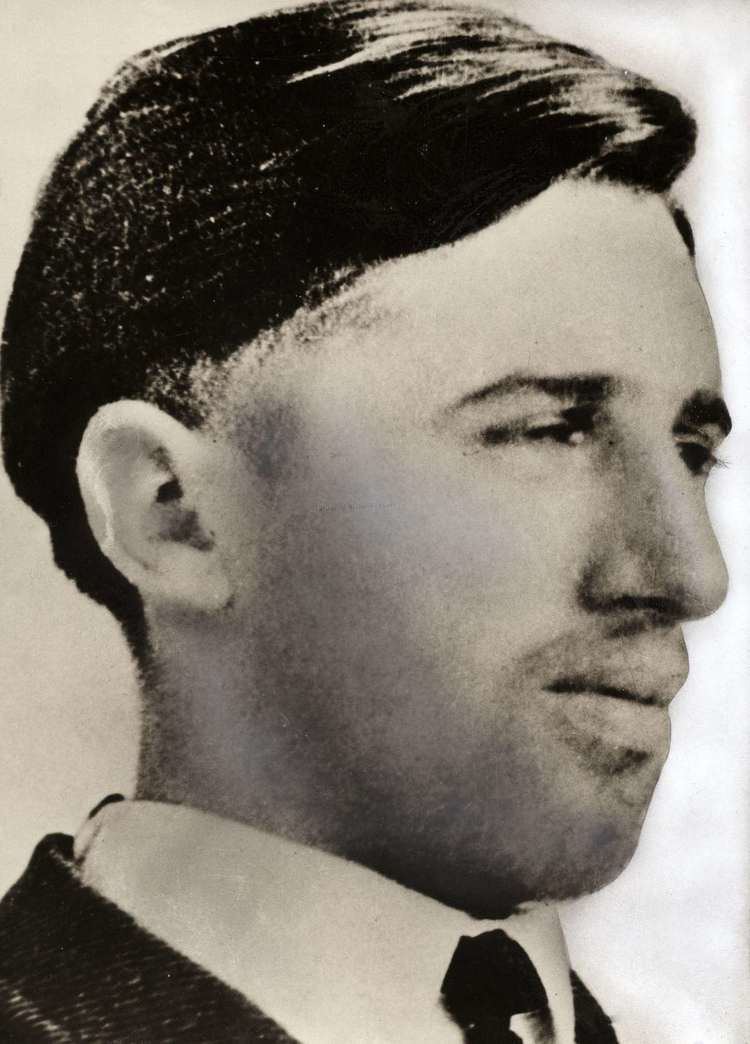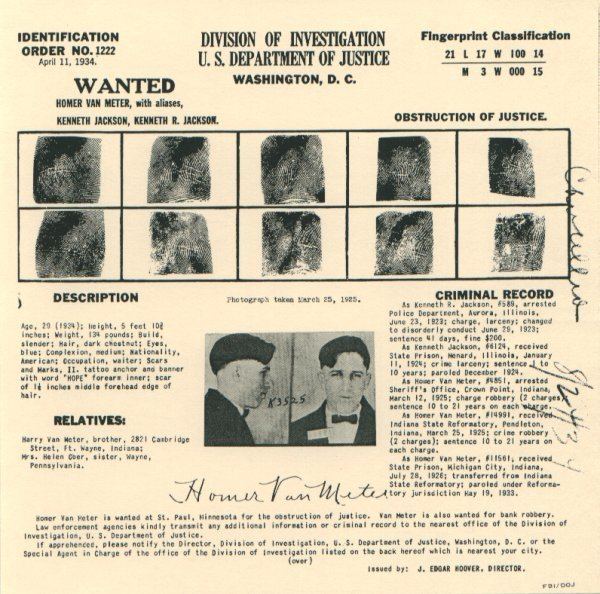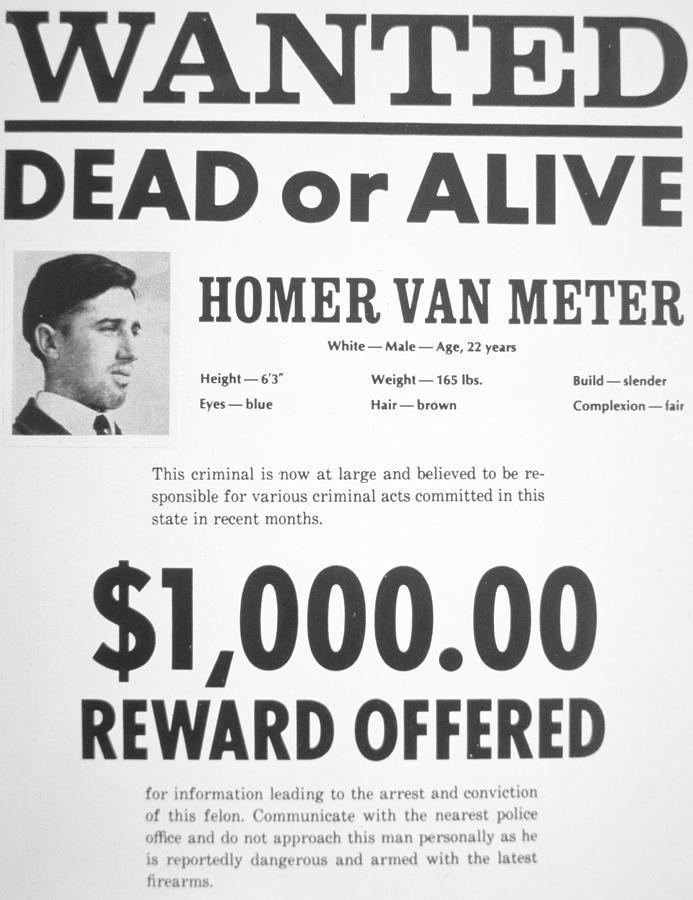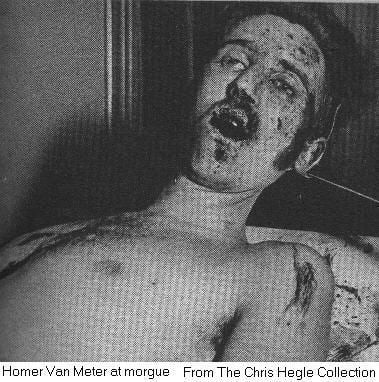Name Homer Meter | ||
 | ||
Full Name Homer Virgil Van Meter Died August 23, 1934, Saint Paul, Minnesota, United States | ||
Homer van meter wax sculpture
Homer Virgil Van Meter (December 3, 1905 – August 23, 1934) was an American criminal and bank robber active in the early 20th century, most notably as a criminal associate of John Dillinger and Baby Face Nelson.
Contents
- Homer van meter wax sculpture
- Harry Dean Stanton in Dillinger 1973
- Early life
- Meeting John Dillinger
- Escape attempts
- Crime wave
- The Second Dillinger Gang
- Death
- Temperament
- In film
- In radio and television
- In print
- References

Harry Dean Stanton in Dillinger (1973)
Early life

Van Meter was born to Cary B. Van Meter (1871–1918) and Julia Miller (1872–1924) in 1905 (according to other sources December 3, 1906) in Fort Wayne, Indiana, the son of an alcoholic railroad conductor. During the sixth grade, Van Meter ran away from home, eventually ending up in Chicago, Illinois, where he worked as a bellhop and a waiter.

He was arrested for the first time as a teenager, for drunk and disorderly conduct. In Aurora, Illinois, on June 23, 1923, Van Meter was sentenced to 41 days in jail for larceny. On January 11, 1924, he was sentenced for motor vehicle theft and incarcerated in Menard Correctional Center. At the time of his admission, he had a tattoo reading "HOPE" on one forearm and a case of syphilis.

Van Meter was paroled in December 1924. Three months later, he teamed up with an old cellmate to rob the passengers of a train in Crown Point, Indiana. He was caught and convicted of the crime, and received a sentence of 10 to 21 years, to be served in the Pendleton Reformatory.
Meeting John Dillinger
While in Pendleton, Van Meter met John Dillinger and Harry Pierpont. Whereas Van Meter befriended Dillinger, he and Pierpont openly despised each other, largely because of Van Meter's clowning antics and demeanor. On July 28, 1925, Van Meter's repeated joking and violation of Pendleton rules earned him a transfer to the state prison at Michigan City.
Escape attempts
In January 1926, Van Meter was transported to Chicago to testify in defense of a man wrongly suspected of being his accomplice for the train robbery in Crown Point. He escaped from the transport at Union Station, but was quickly apprehended by his captors while begging for change on the street. A week later, Van Meter attempted another escape, this time with cellmate Charles Stewart. After sawing through the bars of their cell, the two beat a corrections officer unconscious but were caught before leaving the prison. As a penalty, he spent the next two months in solitary confinement, where he was severely beaten by prison guards.
Crime wave
Afterwards, Van Meter affected a reformation sufficient to allow the parole board to release him on May 19, 1933, one week after Dillinger had made parole. On August 18, Van Meter aligned himself with Baby Face Nelson and Tommy Carroll to rob a bank in Grand Haven, Michigan. They got away with $30,000. On October 23, the trio, along with John Paul Chase and Charles "Chuck" Fisher, robbed a bank in Brainerd, Minnesota, escaping with $32,000. When Illinois published its list of "public enemies" at the end of 1933, Van Meter ranked 18th.
The Second Dillinger Gang
Dillinger broke out of prison in Crown Point, Indiana, on March 3, 1934. Dillinger and John "Red" Hamilton later joined the gang. On March 6, Dillinger, Nelson, Van Meter, Carroll, Eddie Green, and Hamilton robbed the Security National Bank & Trust Company in Sioux Falls, South Dakota. The gang escaped with $49,500 to their hideout in St. Paul, Minnesota. One week later, on March 13, the men robbed the First National Bank in Mason City, Iowa, for $52,000. On April 12, Dillinger and Van Meter robbed a police station in Warsaw, Indiana, stealing firearms and bulletproof vests.
Because of this level of criminal activity, Van Meter and the gang became the subject of an intense FBI manhunt. Eddie Green was ambushed and killed by the F.B.I. on April 3. Days earlier, Van Meter, Dillinger, and Dillinger's girlfriend Billie Frechette had narrowly escaped from police in St. Paul after a gunfight. Later, on April 23, while fleeing from Little Bohemia Lodge, Dillinger, Van Meter and Hamilton were involved in a gun battle in Hastings, Minnesota. Hamilton was mortally wounded and died four days later at the house of Volney Davis. Dillinger, Van Meter, and members of the Barker Gang buried him in a gravel pit near Oswego, Illinois.
On May 3, Van Meter, Dillinger, and Carroll robbed the First National Bank in Fostoria, Ohio, during which Van Meter shot and wounded local police chief Frank Culp. The three spent most of May hiding in a woodland cabin near East Chicago, Indiana. On May 24, while driving a red panel truck through East Chicago, Van Meter and Dillinger were stopped by police detectives Martin O'Brien and Lloyd Mulvihill. Van Meter gunned down both officers with his Tommy gun. On June 7, Carroll was killed in a gunfight in Waterloo, Iowa.
A few days later, in an attempt to conceal their identities, both Dillinger and Van Meter underwent plastic surgery at the hands of Wilhelm Loeser in the apartment of Jimmy Probasco, a bar owner connected to the Chicago Outfit. Loeser operated on Van Meter on June 3. Unsatisfied with the results and, not coincidentally, with the pain of the operation, Van Meter attempted to kill Loeser on the spot.
On June 30, Van Meter, Dillinger, Baby Face Nelson, and an unidentified fourth man robbed the Merchants National Bank in South Bend, Indiana, where Van Meter, serving as lookout, shot and killed patrolman Howard Wagner during the robbery. The fourth man, never identified, has been suggested at times to be Pretty Boy Floyd, Johnny Chase, or Fatso Negri. It was the last confirmed raid for all of the confirmed and suspected participants.
On July 22, FBI agents led by Melvin Purvis and Samuel P. Cowley gunned down Dillinger at the Biograph Theater in Chicago. That night, Van Meter and his girlfriend Marie Comforti fled to St. Paul.
Death
On August 23, at the corner of Marion Street and University Avenue in St. Paul, Van Meter was confronted by four police officers, including Chief Frank Cullen, Detective Tom Brown, and two other men, all heavily armed with rifles and Thompson submachine guns. Brown was a former police chief, who had been notorious for his willingness to take bribes from criminals. Van Meter had previously helped to fund Brown's bid to become sheriff. By this time Brown had been demoted and was under investigation for corruption and allegations that he had been an accomplice to the Barker-Karpis gang in the kidnappings of William Hamm and Edward Bremer. The FBI were interviewing captured former criminal associates.
The officers later claimed Van Meter ignored their command to stop and fled into a nearby alley, where he fired twice on the officers with a .45 caliber pistol. Chief of Police Frank Cullen, armed with a rifle, held his fire as a bystander walked into the line of fire, but the remaining officers opened fire on Van Meter, who fell dead. He was 28 years old. Brown continued to fire at Van Meter as he lay prone; the impact of the bullets ripped off one finger and nearly severed a thumb and finger of the right hand. The body was found to be armed with a .45-caliber Colt automatic pistol. The number and severity of Van Meter's wounds were attributed to the use of the Thompson submachine gun. Van Meter's family later said that their kin had been used for "target practice".
The four officers reported $1,323 found on Van Meter, although his friends and associates claimed he was carrying at least $10,000 on that day. A number of explanations of who betrayed Van Meter to the police have been advanced since his death, including Baby Face Nelson, with whom he had quarreled, by St. Paul crime boss Harry Sawyer and associate Jack Peifer, and by local St. Paul bank robber Tommy Gannon. According to a 1939 FBI interview of one Thomas Kirwin, a handyman who worked on Harry Sawyer's farm north of St. Paul, and who had harbored both Gannon and Van Meter there, Gannon betrayed Van Meter to the St. Paul police in collusion with Peifer and Sawyer, who split $10,000 or so in Van Meter's money with the police, while Gannon was given Van Meter's guns. That same year, the FBI announced that it believed Sawyer had set up Van Meter to get at his money, splitting the take with the four ranking officers who did the shooting.
Van Meter was buried in Lindenwood Cemetery, in Fort Wayne, Indiana.
According to family members, he was not buried within the family plot/area due to shame.
Temperament
There are conflicting accounts of Van Meter's personality, although all agree that he was an inveterate clown and prankster. Of his criminal side, the director of research at the state prison at Michigan City said:
This fellow is a criminal of the most dangerous type. Moral sense is perverted and he has no intention of following anything but a life of crime ... He is a murderer at heart and if society is to be safeguarded, his type must be confined throughout their natural lives.
While not long afterwards, the chaplain at the very same facility described him as follows:
Van Meter ... is ready to prove that he is no longer the man who got off on such a bad start.
